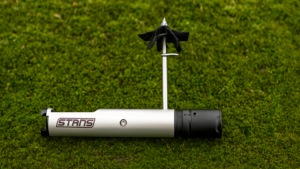Cane Creek's invented RAMP tube, a positive air spring that adds support and bottom out resistance to your plush gravity bike
Coil or air? Cane Creek’s unique Tigon shock gets both, but it’s not enough to lure me away from Fox
Cane Creek has made twin tube coil and air shocks for decades now, including the Kitsuma Coil shock I’ve previously raved about. This new Tigon design represents something entirely new though, promising the sensitivity of a coil spring with the rider-tuneable support of air.
It works like this, the coil spring supports a rider’s weight, before a secondary air spring controls the shock’s progression. The Tigon foregoes the external high-speed rebound adjustment offered by the Cane Creek Kitsuma coil shock, probably because there’s just not enough space for it now. However it does get a thicker shaft and extra structural integrity over the Kitsuma, which will make it more suitable to bikes with clevis-based shock hardware.

The Tigon’s shock shaft is 12.7mm in diamter, making it around a third meatier than Fox’s DHX2 coil
Design and specifications
Tigon shares with other Cane Creek shocks an internal Twin-Tube design that’s been called Double Barrel as far back as I can remember. The idea is that the compression and rebound damping circuits circulate their oil inside between adjustable valves on totally separate independent circuits, rather than flowing back and forth across and internal piston (IFP) like many of the best mountain bike rear shocks.
Fox and Öhlins both share similar designs, with independent tuning in each direction so tweaking rebound damping doesn’t affect compression damping and vice versa (something suspension engineers call crosstalk). Unique to this Cane Creek Tigon though is an extra air spring to tune the ramp up, and it also gets the brand’s proprietary Climb Switch feature that’s currently my favourite shock lock-out on the market.

Adjust the RAMP tube with a regular shock pump for air cans, the maximum pressure is just 30psi but it’s enough to create a big effect on the trail
The ramp up chamber works a bit like an air-assisted rather than hydraulic bump stop. In this instance it takes effect higher in the travel rather than right at the end though, or about half way through the stroke, according to the brand’s graphs. It is especially designed to add up to 35% extra progressivity for bikes that have a linear suspension curve and would otherwise bottom too easily with a coil spring. It’s not limitd to linear bikes though, it can also be used to add extra ramp or support deeper in the travel on any frame that’ll fit it.
The part of the shock responsible for this is something Cane Creek calls RAMP Tube, which inflates to a maximum of 30psi and wraps around a significantly fatter Tigon damper shaft in the middle of the coil spring. The damper shaft gets a larger diameter than usual, presumably to better withstand side-loading and buckling forces that can harm traditional coil shocks with thinner shafts, and to better fit the RAMP Tube design.

The Tigon is especially useful for bikes that use asymetrical frame designs, like the Spcialized Enduro, which need more lateral support
Reading between the lines part of the motivation for this product must have been to make a coil product that has as much structural integrity as an air shock. That’s especially useful on bikes using asymetrical designs like Specialized, where the shock almost becomes an integral part of the chassis, and coils shocks aren’t endorsed due to side forces potentially bending the damper shaft.
This thicker Tigon damper shaft demands a wraparound seal not dissimilar in size to an air can and shaft. Whether or not this seal has to be as tight and robust though, containing just 30psi maximum rather than up to 300psi in a standard air shock, is something I’m not entirely sure about.
Another aspect this Tigon coil hybrid shares with an air shock is its negative spring. In a normal air shock, a negative air spring essentially balances the positive spring at sag and pushes the damper into its travel, overcoming seal friction. Cane Creek’s mechanical negative coil spring has the same purpose of maintaining suppleness here in the Tigon.
Coil springs are typically all about downhill performance and sensitivity, but there’s little sacrifice on the climbs thanks to Cane Creek’s clever sweeping CS lever. It stabilises the bike in both directions to support against pedal bob and calm the shock’s movement, all the while retaining traction and control for technical climbing. The firmer mode is really effective to the point of almost full lockout, and the dull and smooth feel when locked out trumps rivals’ low-speed compression-only platforms that can come over stuttery and sharp on rougher ground.

Low speed rebound and compression dials help you tune in the ride, and there’s a sweeping climb switch I found really effective
There are only three externally adjustable damper dials here, to the Kitsuma’s four. You get indexed low-speed rebound and compression, and a sweeping high-speed compression dial that’s less precise – you just have to experiment with it. All three require an allen key to dial in, and Cane Creek thoughtfully includes a tiny one that’s held securely in place magnetically. I found it can also fit into small gaps and angles on awkward frame fitments.
Performance
I’ll stick my neck out and say from the off that, while it’s a subtle difference, I wasn’t quite getting the same isolating and fluid sensation here you can with the best coil shocks. Compared to the Cane Creek’s Kitsuma shock I’ve previously tested and ridden plenty, it’s harder to get that floating-on-a-cloud feeling riding along with this Tigon, even if you run its damping settings very open.
So, before I delve into what RAMP Tube can offer, I’ll summarise by saying that unlike the Kitsuma there’s a feeling of slightly more stodginess and lag when changing direction. You don’t get on the Fox DHX2 I back-to-backed with on the same bike.

My test bike was the Yeti SB165, a bike that comes with the excellent Fox DHX2 coil installed as standard
I installed Cane Creek’s shock on a Yeti SB165, a bike that came with a Fox DHX2 Factory-level damper. For my money, the grip and tracking levels simply weren’t at the same level when using the same weight 500lb spring, despite testing on the same tracks on the same day. Of course, there could be a case of spring rates between brands not being completely in sync (a firmer spring will feel, err, firmer), but it’s very rare for this to be more than 25lb or so out. What I really felt was a significant difference in suppleness and fluidity, no matter how open or closed I ran the Tigon damper settings. The Tigon also felt duller and slower, even with the rebound set wide open.
It’s only a theory, but I’m ascribing this duller and less active feel to the Tigon’s thicker damper shaft and an extra seal in the RAMP Tube, both of which could be adding friction. Whether this friction is anything like at the same level as you get on a coil shock I can’t say for sure, because the pressures are so low in the RAMP Tube (or for me, non-existent during much of testing on the already-progressive Yeti). What I can say is it’s missing that large volume negative air spring that would naturally overcome any friction from an air shock.
I’ve started the review with this angle of performance is as it’s important, but it’s also worth saying this is a very subtle effect. The Tigon still feels like a coil shock in many ways and is definitely smooth and supple, there’s just less of the ridiculous grip and tracking you get from most coil shocks. It’s a hassle to go coil considering the extra weight, cost and difficultly getting perfect set up with fixed spring rates, making the Tigon less relevant.

The RAMP tube is a cool idea and unique in the mountain bike world, but it’s almost wasted on a shock that’s a touch too sticky and tight
The RAMP tube
This is one part of performance, but what about the unique extra air spring to add support and bottom out resistance? While I’m sure it’s better suited to a bike with a more linear leverage curve, you can immediately feel the effects of adding extra air and sometimes it’s really pretty cool what it does to the ride.
In bike park situations, like at Dyfi, hitting massive deep berms and big jumps, you can almost adjust the bike’s dynamic ride height by adding 25psi into the RAMP Tube. You gain absolutely tons of support in the mid-stroke and that feels fantastic pumping through big holes and blasting off lip faces.
With the air/coil hybrid, the bike becomes much punchier and bouncier and just feels tighter and peppier all-round, without any negative effect on off-camber or first-touch grip that you need to keep you safe in the corners. One big trade-off, however, is that over successive big hits and brake-battered sections you really feel the extra ramp up and loss in travel, so it can come over as a much rougher ride.

The unique blending of air and coil springs could be a useful addition for riders who want their bikes tight and supportive for trail riding, or plush for gravity applications
My Tigon summary then is the air spring aspect could definitely prove useful and can bring a sensation many riders might like on any bike. For example, being able to add air and tightness to a longer travel bike for more trail bike type riding, before taking that air out for a plusher feel on gravity stuff. Overall it’s not quite as supple and sensitive with same level of damping dimensional control as Cane Creek’s Kitsuma though. So where that shock (or the DHX2) can feedback terrain like a blind man’s finger reading braille and trace every minute contour, the Tigon hasn’t quite as much grip or that sensation of reading every little imprint of root, stone, bump and ripple.
Verdict
Cane Creek’s Tigon is a unique product offering something other coil shocks simply can’t with its RAMP Tube technology. With most modern enduro bikes being progressive enough for a standard coil shock though it’s a bit of a niche product that won't suit all bikes. And it's not one I’d normally choose over the brand’s regular Kitsuma shock for sensitivity, maximum DH performance and control. The extremely rampy sensation with extra air added can be fun though and adds support and punch to make a longer travel bike feel really tight and energetic in bike park situations. Plus the thicker damper shaft also adds structural support to clevis mounted frame designs not otherwise suitable for coil shocks.
















